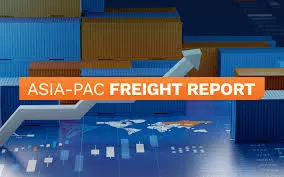Disruptions in the Asia Freight Market
The Asia-Pacific freight market is experiencing notable upheavals according to the latest insights. Dimerco Express Group’s August report sheds light on significant alterations in global trade routes, increased freight rates, and persistent challenges for exporters in India and other parts of Asia.
Overview of the Current Freight Landscape
The global shipping industry is currently facing one of its most intense transformations in recent years. Various factors, including new tariffs imposed by the US, adverse weather conditions, and fluctuating demand are complicating matters for freight forwarders, exporters, and logistics organizations.
New Tariffs and Their Immediate Effects
Beginning August 1st, the US initiated new “reciprocal tariffs” affecting over 25 countries, predominantly in Asia. This policy means goods entering the US from these nations are subject to elevated import duties. Consequently, many companies attempted to export goods in July prior to the tariff implementations, resulting in a surge of shipments followed by a sharp decline at the start of August, causing confusion and vacant slots on various routes.
As Alvin Fuh, Vice President of Ocean Freight at Dimerco, remarked, “These are not just small changes in freight movement; this signifies a fundamental shift in the mechanics of global trade. Shippers and logistics firms must adapt their planning and operations accordingly.”
Increased Demand and Higher Freight Rates
In regions such as India, Taiwan, and Southeast Asia, the demand for flights to the US has surged significantly. This spike has led to increased rates and a scarcity of available space on key shipping routes. For example, air freight from Taiwan to India has encountered substantial delays due to capacity issues in cities like Mumbai and Chennai.
- High demand for routes to the US from India and other Asian countries
- Challenges with capacity and rates in popular air freight lanes
- Soft demand in certain Europe-bound and intra-Asian routes
Marine Shipping Challenges
The situation is also complicated within the ocean freight domain. Following the pre-tariff shipping rush in July, demand has begun to fall off, leading to a decline in ocean freight rates on some lanes. However, shipping companies are counteracting excess capacity by canceling sailings, referred to as “blank sailings,” especially on routes between Asia and the US, which adds to the uncertainty and delays exporters are facing.
Mixed Developments for Indian and Southeast Asian Exporters
The air freight market in India remains under strain as shipments to the US rise. Unfortunately, the ongoing monsoon is wreaking havoc, disrupting trucking, warehouse operations, and flight schedules. It’s been advised that shippers use waterproof packaging to protect their cargo from the rain.
Southeast Asia faces its unique set of hurdles as nations like Vietnam, Thailand, Malaysia, and the Philippines grapple with intense demand and high tariffs. For instance, Thailand is currently facing the highest US tariff rate in the region at 36%, while Malaysia is contending with a 25% tariff amid severe congestion at Port Klang. Vietnam’s air cargo is tight due to port delays, and the Philippines is bracing for typhoons, pushing shippers to expedite their exports to circumvent weather-related or tariff complications.
Weather and Geopolitical Influences Increasing Uncertainty
The monsoon rain in South Asia and the typhoon season in East Asia are major factors causing logistical delays. Operations in locales like South Korea and Vietnam are being disrupted by inclement weather, proving challenging for logistics companies aimed at maintaining timely deliveries.
Additionally, tensions in the Middle East are forcing shipping routes to adjust, with vessels overstepping traditional paths to circumvent conflict, which inevitably escalates delivery times and costs for shipping between Asia, Europe, and the US.
What’s Next for Shippers?
Experts from Dimerco urge shippers to:
- Stay informed about the latest tariff announcements from the US.
- Plan shipments in advance, especially during peak seasons or adverse weather.
- Utilize waterproof packaging to secure goods against wet weather.
- Consider flexible routing options and alternative ports.
- Book space for ocean and air cargo early to mitigate rising costs or delays.
Kathy Liu, Vice President of Global Sales and Marketing at Dimerco, advises, “Old shipping patterns are obsolete. It’s crucial to comprehend how trade policies, weather variables, and nuances at the local level can steer your supply chain.”
Conclusion: The Future of Global Logistics
The freight landscape in Asia is undeniably shifting, presenting a complex tapestry of opportunities and challenges for exporters. Understanding and addressing these elements is vital for businesses seeking to thrive in a competitive environment.
In light of the current circumstances, GetTransport.com emerges as a reliable solution for navigating these logistics hurdles. Offering affordable global cargo transportation options, it caters to diverse relocation needs—from private home moves to commercial freight solutions. With a commitment to transparency and extensive offerings, GetTransport.com makes logistics seamless and efficient. Don’t hesitate; Rezervujte si teraz and experience the convenience of reliable logistics with GetTransport.com.

